
The Royal Horticultural Society (RHS), founded in 1804 as the Horticultural Society of London, is the UK's leading gardening charity.

Osteospermum, is a genus of flowering plants belonging to the Calenduleae, one of the smaller tribes of the sunflower/daisy family Asteraceae. They are known as the daisybushes or African daisies.

Leucanthemum vulgare, commonly known as the ox-eye daisy, oxeye daisy, dog daisy, marguerite and other common names, is a widespread flowering plant native to Europe and the temperate regions of Asia, and an introduced plant to North America, Australia and New Zealand.
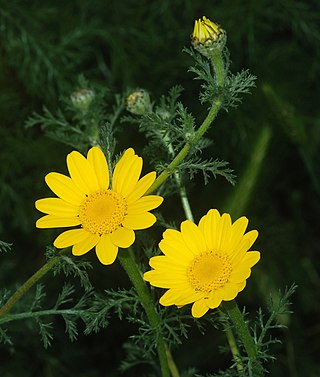
Cota tinctoria, the golden marguerite, yellow chamomile, or oxeye chamomile, is a species of perennial flowering plant in the sunflower family. Other common names include dyer's chamomile, Boston daisy, and Paris daisy. In horticulture this plant is still widely referred to by its synonym Anthemis tinctoria.
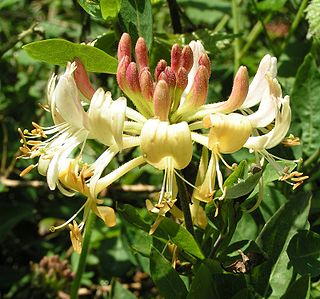
Lonicera periclymenum, common names honeysuckle, common honeysuckle, European honeysuckle, or woodbine, is a species of flowering plant in the family Caprifoliaceae native to much of Europe, North Africa, Turkey and the Caucasus. It is found as far north as southern Norway and Sweden.

Rudbeckia hirta, commonly called black-eyed Susan, is a North American flowering plant in the family Asteraceae, native to Eastern and Central North America and naturalized in the Western part of the continent as well as in China. It has now been found in all 10 Canadian Provinces and all 48 of the states in the contiguous United States.

Silene chalcedonica, the Maltese-cross or scarlet lychnis, is a species of flowering plant in the family Caryophyllaceae, native to central and eastern Russia, Kazakhstan, Mongolia and northwestern China. Other common names include flower of Bristol, Jerusalem cross and nonesuch.

Prunus serotina, commonly called black cherry, wild black cherry, rum cherry, or mountain black cherry, is a deciduous tree or shrub of the genus Prunus. Despite being called black cherry, it is not very closely related to the commonly cultivated cherries such as sweet cherry, sour cherry and Japanese flowering cherries which belong to Prunus subg. Cerasus. Instead, P. serotina belongs to Prunus subg. Padus, a subgenus also including Eurasian bird cherry and chokecherry. The species is widespread and common in North America and South America.

Primula elatior, the oxlip, is a species of flowering plant in the family Primulaceae, native to nutrient-poor and calcium-rich damp woods and meadows throughout Europe, with northern borders in Denmark and southern parts of Sweden, eastwards to the Altai Mountains and on the Kola Peninsula in Russia, and westwards in the British Isles.

Echinacea purpurea, the eastern purple coneflower, purple coneflower, hedgehog coneflower, or echinacea, is a North American species of flowering plant in the family Asteraceae. It is native to parts of eastern North America and present to some extent in the wild in much of the eastern, southeastern and midwestern United States as well as in the Canadian Province of Ontario. It is most common in the Ozarks and in the Mississippi/Ohio Valley. Its habitats include dry open woods, prairies and barrens.

Christopher "Christo" Hamilton Lloyd, OBE was an English gardener and a gardening author of note, as the 20th-century chronicler for thickly planted, labour-intensive country gardening.

Symphyotrichum novi-belgii, commonly called New York aster, is a species of flowering plant. It is the type species for Symphyotrichum, a genus in the family Asteraceae, whose species were once considered to be part of the genus Aster. Plants in both these genera are popularly known as Michaelmas daisy because they bloom around September 29, St. Michael’s Day.
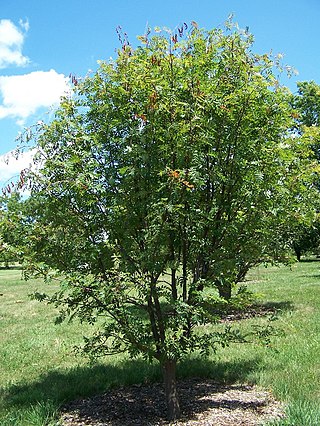
Sorbus commixta, the Japanese rowan, is a species of flowering plant in the family Rosaceae, native to Japan, Sakhalin, and the Korean island of Ulleungdo.

Farfugium japonicum is a species of flowering plant in the family Asteraceae, also known as leopard plant, green leopard plant or tractor seat plant. It is native to streams and seashores of Japan, where it is called tsuwabuki (石蕗).

Euryops pectinatus, the grey-leaved euryops, is a species of flowering plant in the family Asteraceae, endemic to rocky, sandstone slopes in the Western Cape of South Africa.

Leucanthemella is a genus of flowering plants in the sunflower/daisy family Asteraceae.

Fothergilla major, the large witch alder or mountain witch alder, is a species of flowering plant in the genus Fothergilla, family Hamamelidaceae, that is native to woodland and swamps in the Allegheny Mountains and southern Appalachian Mountains of the southeastern United States. It is a deciduous shrub growing to 2.5 m with fragrant white bottlebrush flowers appearing along with, or before, the glossy leaves. The leaves often turn brilliant shades of red and orange in autumn.
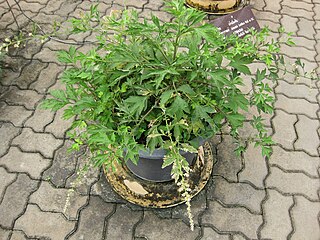
Artemisia lactiflora, the white mugwort, is a species of flowering plant in the daisy family, native to western China. It is a vigorous clump-forming herbaceous perennial growing to 1.5m, with plumes of creamy-white flower heads appearing in summer and autumn above dark green leaves. This is the only artemisia which is cultivated as much for its flowers as for its foliage. Plants grown in poor dry soil are hardier and last longer than those grown in heavy, damp soil.
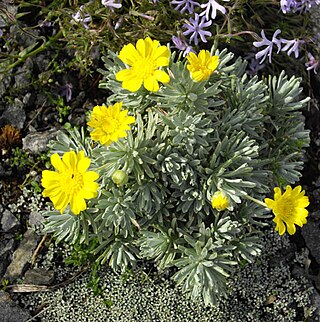
Euryops acraeus, the mountain euryops, is a species of flowering plant in the daisy family Asteraceae, native to the Drakensberg Mountains of South Africa. It is a dwarf, rounded evergreen shrub growing to 30 cm (12 in) tall and wide, with silver-blue leaves and masses of yellow composite flowers in spring and summer.

Dimorphotheca jucunda, the delightful African daisy, is a species of flowering plant in the family Asteraceae. It is native to South Africa, Lesotho and Eswatini, and introduced to Ireland and Tasmania. As its synonym Osteospermum jucundum, it and two of its cultivars, 'Blackthorn Seedling' and 'Langtrees' have gained the Royal Horticultural Society's Award of Garden Merit.




















